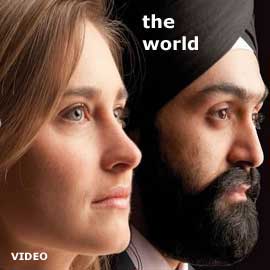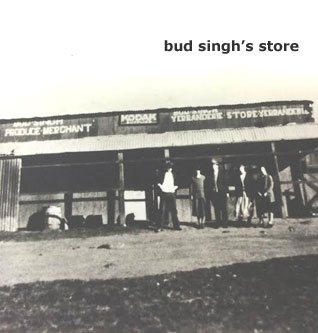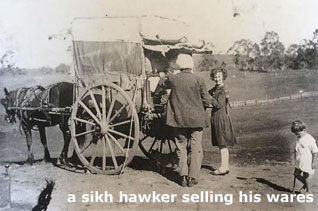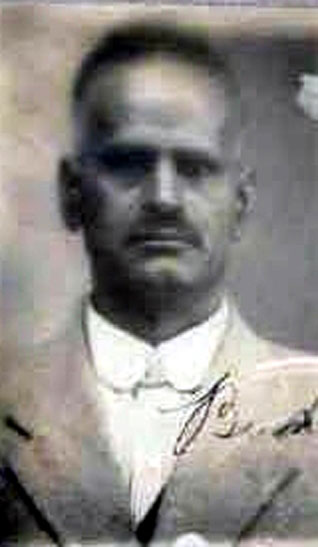Columnists
Big Man Yerranderie:
Sikh-Aussie Pioneer Bud Singh
MANPREET KAUR SINGH
Bud Singh was one of many thousands of Sikhs who came to Australia in the late 19th and early 20th century.
Like thousands of his fellow countrymen and pioneer Sikh-Australians, he worked as a hawker, selling goods in small country towns. He was much loved by the local community and always made generous donations to the local hospital or charitable organisation.
But what makes Bud Singh unique is that in the early 1900s, he was made a life member on the Board of the Camden Hospital (in New South Wales), and now in the year 2014, the hospital will hold a special ceremony to reinstate a plaque to honour Bud Singh as one of its earliest benefactors!
According to historian Len Kenna, “Although numerous memorials of Sikh and Indian hawkers dot the countryside wherever you go in rural Australia, all of these memorials were erected posthumously – after the hawkers died. Bud is unique that he was acknowledged by the Yerranderie community during his lifetime -- and so, the upcoming commemoration at Camden hospital will acknowledge all of the other Sikh and Indian hawkers, who contributed heavily to the development of Australia in the early 20th century.
Here is what we know of Bud Singh (probably “Budh Singh”).
He was born in Punjab in 1873 and reached Australia in 1899. He began work as a hawker on foot, who carried his goods in a basket, and soon earned enough to buy a horse cart. He then opened a general store in Yerranderie, invested in the local tin mines and went on to become quite wealthy.
Says Len Kenna, from the Australian Indian Historical Society, “Bud was very involved in the local community. He was a member of the Rifle Club, the Bike Riding Club, the Athletics Club, you name it. He was heavily involved with the Red Cross and was a donor to the Camden Hospital. He was even a judge at a local music competition, which tells you that he participated in everything.”
Len estimates that there were around 30,000 hawkers from the subcontinent (mostly from Punjab, and generally Sikh), working in country-towns around Australia in the early 1900s.
“Conforming to the pillar of Sikh belief to do good deeds and offer your services to the community, 90% of these hawkers donated part of their wages to the local hospital. The wonderful thing about Bud was that he managed to become a life member of the hospital board, and his name was painted alongside the Who’s Who of Yerranderie at that time. That in itself questions the White Australia policy as we know it”.
Bud was a very successful businessman, who frequently traveled to Sydney and Melbourne to turn over his merchandise. Local newspapers printed his boastful advertisements for “new, cheaper and better goods” and he was considered to be a part of the town’s elite.
Len adds, “Bud was a very colourful character though, who ruffled many feathers back then.” He ended up in court numerous times – all the proceedings are well documented – but Len feels that, “the fact that we find so much folklore about Bud means that he was a much loved character in Yerranderie – Camden area”.
An account written by Norman Dunn, who worked at Bud’s store, says “About 1904, he established a small general store in Yerranderie. Though he could neither read nor write, he could read figures and sign his name and the shop did well … He paid me 12/- a week, and my family got all the purchases at cost price. Bud treated me well. I found him to be a good, kind man.”
There is a humorous account by Norman Dunn, about a time that Bud felt “spurned”, but he avenged the insult to his “stature” quite publicly.
A meeting was convened at Yerranderie to invite Mr Griffiths, the Minister for Railways, to consider a new rail line between the town and Camden. The convenors invited the cream of the town to the meeting, but overlooked Bud Singh.
On his part, Bud Singh mounted his equally famous horse, “Paddy” and caught up with Mr Griffith even before he reached the venue and said,” Mr Griffiths, I big store-keeper Janderie. I welcome you Janderie.”
It is fabled that he earned the nick-name “Me Big Man Yerranderie” thereon!
Another account by Jack Stein states this about Bud Singh: “His name is on the plaque of the Camden District Hospital. He gave £100 a year to the hospital. He was a gentleman, an ex-cavalryman in the Indian Army, who lost one eye in an uprising in India.”
But these are just verbal accounts which may well be retelling pompous tales, particularly the story about Bud’s eye being lost in a war in India. Crystal Jordan, also from the Australian Indian Historical Society explains that there is a court trial about when Bud seemed to have lost his eye.
She says, ”Five men attacked Bud in his general store one day, probably because he kept all his cash under the floor-boards. The attack was quite vicious and Bud was taken to the hospital immediately. In the ensuing court case, the attackers were charged with assault and the judge posted an astronomical bail amount of £500. To put this in context, that amount was virtually unpayable back then, since the average wage was around £2 per week in those days.
“But we believe that’s when Bud lost his eye, and not in any war, because he probably wouldn’t have been allowed to enter Australia if he was blind in one eye.”
So even though there’s a photo of Bud Singh in some sort of military uniform, it cannot be attributed to any particular army or regiment since it has no identifying feature – perhaps it was Bud’s way of adding “more spice” to his personal story.
But a very important (and well documented) aspect of Bud Singh’s story is that although he came to Australia at the turn of the 20th century, and established himself as a very wealthy man, he went back to Punjab in 1926 -- never to return.
And maybe, just maybe, his descendants are alive and well, back in Punjab!
Crystal has found the records from back in 1926, that indicate that Bud left on a ship called Moldavia from the Woolloomooloo Wharf. The local newspaper states that “ he was farewelled by many of his turbaned friends.”
But Len feels that Bud intended to return back to Australia, because he still had property in his name, back here. Says Len, “I believe that when Bud left in 1926, he had plans to come back, because he owned assets here, including some freehold land in Yerranderie. If he intended to go away for good, he wouldn’t have left his property unattended.”
Crystal’s research reveals that the authorities actually auctioned this land in 1952 to recover unpaid taxes for the previous 26 years.
According to the records, the “Overdue Rates amounted to £6/12/6 ($ 13.26 AUD) on the land at lot 57 Quiq Street and Dobson Street, Quiqtown, Yerranderie, NSW in 1952.”
There is also a note that states that when this land was auctioned, Bud Singh was deceased by then. Len believes that “Bud fell ill and died in Punjab, or perhaps, died on his way back home”.
But Crystal believes that if his descendants are still living in Punjab, it shouldn’t be hard to identify Bud from the portrait photo she’s found.
“Bud left Australia when he was aged in his early 50s, and he was a very wealthy man, so someone in Punjab should be able to identify him from this picture,” she says hopefully.
So while the search is on for Bud’s descendants in Punjab, many people in Australia are waiting for the commemoration at Camden Hospital in NSW, which is expected to be held sometime in May 2014.
As Len and Crystal say, “Bud Singh wasn’t unique in that he donated to the local hospital. Almost all Sikh hawkers donated in cash, kind or in other ways.
“We know of a potato farmer in Victoria who donated 100 tonnes of potatoes to hospitals around the state, and also donated to the World War 1 efforts; there was Sunda Singh of Portland who donated regularly to the hospital and even paid for the whole hospital to be re-painted … he paid for paint and labour, which must have been really expensive; and there was the Sondhu family from Harrow who donated their land for community use.
“So many Sikh-Australians did exactly what Bud did, and perhaps more. But now that the plaque will be reinstated in his honour at Camden Hosptial, it will be a symbol of acknowledgement of all those other acts of kindness that have since, been forgotten.”
Len goes on to add, “This will become a symbol and a reminder of the Sikh contribution to the development of Australia at the turn of the 20th century. The tragedy is that Australia’s ethnic history hasn’t been documented and people mistakenly believe that the country was built merely on the contributions of the British or the Anglo Saxon people. But that’s not true. Punjab’s contribution to Australia’s development must be told and must be accepted as part of our history here.”
Crystal adds, “I think its also very important for the Sikhs in Australia to know more about the heritage that they have inherited, so that they can embrace it and feel good about the contribution of Sikhs have made to the development of Australia.”
Audio link and photo galleries related to this story can be accessed by CLICKING here.
Also, please CLICK here to hear Interview with historians Len Kenna and Crystal Jordan.
April 24, 2014
Conversation about this article
1: Sunny Grewal (Abbotsford, British Columbia, Canada), April 24, 2014, 10:48 AM.
I had absolutely no knowledge of the history of Sikhs in Australia. This is a great article. I hope Bud Singh made it back home to Punjab and did not pass away on his way there.
2: Baljinder Singh (Sydney, Australia), April 24, 2014, 5:04 PM.
We hope too that Bud Singh made it back home to Punjab but one thing for sure, Bud Singh had made his home in Australia as have Sikhs around the world, wherever they have settled. Iss virsey di virasat de varsan di dastaan vi saadi ae, aauo ral ke sambaal laeeye saadian pahilan banaie oh pehchaan vi saadie ae. Thanks, Bud Singh ji. And ... beautifully written, Manpreet Kaur ji.
3: Baldev Singh (Bradford, United Kingdom), April 24, 2014, 8:45 PM.
This is an extraordinary story about extraordinary and generous Sikhs donating to hospitals in Australia! I am tempted to get involved and find out more and if I get the chance I will definitely try to visit this place and in the meantime I would like to thank all of Bud Singh's fellow Australians on their recognition of a kind gentleman from the Punjab ...
4: Ari Singh (Sofia, Bulgaria), April 25, 2014, 2:18 PM.
Bud Singh is a typical Sikh: noble, gallant, charitable and business-minded. 250 years of our Gurus have moulded the Sikh community into a unique race.
5: Baljinder Singh (Sydney, Australia), April 25, 2014, 7:28 PM.
You will be most welcome in Camden (Sydney). Your Respect for Bud Singh ji is highly appreciated. Please spread the true story of Bud Singh.






